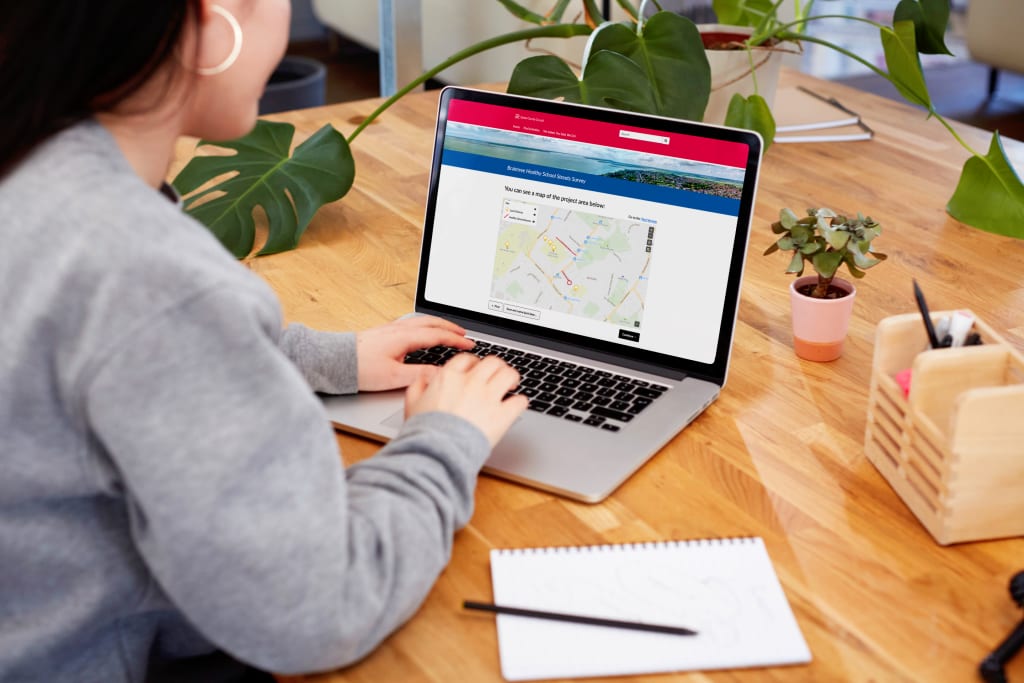
Community engagement is a vital part of any government strategy or consultation. It’s essential legislative bodies consult with the public on new initiatives and provide them with a way to air their concerns and feedback on the potential impact on their community.
What is Community Engagement?

Community engagement encourages citizens, groups, organisations and institutions to actively participate in discussions about changes in their community. This can mean informal methods such as group meetings, or more formal consultations with official bodies. Together, these groups and individuals address shared concerns and desires for their neighbourhood in a collaborative way.
This promotes a sense of shared responsibility for what occurs in their community and involves them in the decision-making process. Governments, public sector bodies and local authorities play a crucial role in community engagement, building relationships with citizens and developing meaningful solutions that values all contributions. Through public participation in community engagement initiatives, governments can build trust, enhance transparency, and ultimately, improve outcomes for communities.
The Difference Between Community Engagement and Citizen Engagement

Are they really that different?
Well, although they’re sometimes used interchangeably, community engagement and citizen engagement actually have slightly different meanings.
Typically, the easiest way to differentiate between the two is if something targets a group of citizens or individuals.
Community engagement involves organisations, grassroots groups, community groups, businesses, residents etc. all liaising with stakeholders in both informal and formal discussions. Community engagement can be citizen or stakeholder led and it focusses on hearing the collective views and goals of communities. These discussions then influence decisions made by stakeholders.
This is done through informal meetings, community forums, participatory budgeting and consultations, among other community-driven engagement events.
Citizen engagement on the other hand focuses on individual needs, desires and concerns and initiatives are usually government or stakeholder-led. It’s where citizens are individually involved in the decision-making process via statutory and public consultations, providing feedback on government proposals. Rather than reflecting the needs of a group, citizen engagement reflects the needs of individuals in a society.
Both are necessary for good policy planning and government interaction with citizens. Following the steps on the Ladder of Participation and adhering to the 4 Gunning Principles during the consultation process builds trust between governments and citizens.
5 Types of Community Engagement

As community engagement focuses on collaboration with organisations and groups over individuals, the types of engagement can be both formal and informal. Some of the most effective community engagement tactics include:
Public meetings:
Hosting town halls, creating a community forum or public hearing to discuss issues and gain input from residents is an effective, informal way for stakeholders to engage with the public.
Community workshops or events
Organising workshops or community events focussed on specific topics lets representatives provide ongoing input and advise on specific policies or issues.
Advisory boards and committees
Forming an advisory board or committee made up of a group of community representatives lets the government establish an ongoing dialogue with citizens.
Participatory budgeting
Participatory budgeting is all about deliberative prioritisation – asking community members how they would allocate public budget based on their needs. Delib’s Budget Simulator allows citizens to actively make these choices so they can understand the impact and trade-offs that need to occur for certain initiatives to succeed.
Social media
By creating accounts and engaging with the public online, stakeholders can share new initiatives, developments and changes in a community, while listening to public feedback.
These are just a few examples of ways the government can actively communicate with community groups and build a dialogue.
Why Is Community Engagement Important?
Community engagement is essential in building trust and developing relationships between stakeholders and citizens. By empowering them to take part in the decision-making process, governments ensure policies and imitative are consider the needs of the community at large.
The Key Benefits of Community Engagement

An effective community engagement strategy needs to open a dialogue that encourages both public and stakeholder engagement. There are many benefits to community engagement, including:
Inclusivity
Community engagement promotes inclusivity. By offering multiple avenues, and speaking with multiple community groups that will be affected by changes, stakeholders are showing they care about listening to all viewpoints.
The advent of methods like creating town halls or advisory boards helps narrow the digital divide, providing a way for everyone to contribute.
Transparency
Community engagement is a big part of building trust. Government groups and public sector bodies that are fully transparent in their decision-making process provide insights that allow the public to understand why decisions have been made and what priorities are in place.
Showing how their input affected the ultimate decision greatly affects the general sentiment toward the end result.
Informed decision making
Of course, stakeholders and government groups don’t always have the same intimate knowledge of an area as the community that lives, works and plays there does. By acknowledging that and asking for their input, they can better understand the ultimate impact changes will have on an area, and potentially change their perception of the effect of certain policies or decisions.
Empowerment
Community engagement lets individuals and groups actively participate in the decisions that shape their community. This lends to a feeling of ownership and agency having contributed to the changes being made.
Enhanced participation
By providing residents and communities with multiple ways to contribute to the overall decision-making process, more people are able to have their say. It encourages residents and makes them more aware that these options are available, leading to greater citizen education and awareness.
Challenges of Community Engagement

While community engagement is an important and integral part of relationship-building and government consultation processes, as with anything, there are challenges with refining your strategy.
Inclusivity
A great strength and benefit of community engagement – but also a challenge. How do you ensure your community engagement is inclusive? A great way is offering multiple methods of communication and delivery, both on and offline. This helps marginalised people participate and lowers barriers surrounding literacy.
Resource constraints
Community engagement requires logistics, time and money, in other words… resources. Governments need to prepare for this in budget planning for new initiatives and ensure they are able to access the right support to successfully execute community engagement plans.
Sustainability
Right alongside resource constraints, we have the question of keeping these community outreach groups, advisory boards and events running long-term. Any planned community engagement needs to be sustainable long term, otherwise it seems like an empty gesture.
Measuring success and impact
It can be hard to come up with concrete “return on investment” statistics for community engagement activities; which is unfortunately what appeals to stakeholders. Sometimes there’s a misconception about the impact these activities have as we are unable to provide directly measurable outcomes.
Power dynamics and trust
Addressing power imbalances and building trust between stakeholders and the community can be challenging. This is especially true in communities where there are historical tensions, conflicts of interest, or a lack of trust towards institutions and decision-makers.
Creating a Community Engagement Plan: Best Practices

For any successful community engagement activity or strategy, you need a good plan in place to ensure it’s effective.
You need an ultimate step-by-step guide, which is just what we here at Delib have created.
Check it out:
Step One: Planning Phase
During the planning phase, you want to do some serious market research. You need to understand the communities you’re reaching out to. Their needs, priorities, demographics and what resources they already have in place.
Identify the best contacts and relevant groups and what the overall goals of the community engagement strategy are.
From there, define how you’ll measure success, your budget, your overall timeline and plan out when community engagement outreach should take place.
It’s at this stage that all the resources, challenges and priorities should be assessed and carefully established.
Step Two: Strategising
You’ve clearly laid out a plan and schedule for what community engagement activities to pursue, which groups to target, and how to measure the outcomes; now you need to choose the most appropriate engagement activities.
Consider which types are most likely to appeal to those in the community groups you want to engage with and make sure you’re using a mixture of offline and online resources.
Promote accessibility and inclusivity and develop communication materials in plain English for more effective communication.
Step Three: Implementation
Stick to your schedule, changing up dates or times at the last minute can promote mistrust.
Provide opportunities for community leaders to engage with stakeholders and feel like their opinion is heard and taken on board.
Define a set of metrics for tracking the success of community engagement and a strong feedback process that shows open dialogue results in change.
Step Four: Evaluation
Evaluate the success of your engagement measures qualitatively and quantitively.
Ensure to get feedback from stakeholders and community group members and close the feedback loop by feeding back the results.
Once everything is complete, assess and make improvements for the next outreach activity or ongoing support.
Best Examples of Community Engagement

For the online section of community engagement planning, a unified, centralised system is hugely beneficial.
If you can provide an inclusive, accessibility- friendly and interactive way to engage with community members, response rates soar.
Stockport Clinical Commissioning Group UK
A great example of mixing online and offline strategies for effective community engagement is Stockport Clinical Commissioning Group UK.
Using Citizen Space as their centralised online source, they were able to ensure their community engagement was accessible and inclusive by offering sign language videos of each question for deaf patients and provide plenty of plain English background information to help contextualise questions.
Stockport CCG also made their engagement mobile, taking iPads into GP surgeries, creating focus groups, events and meetings and paper-based surveys and patient reference groups.
Once complete, they successfully closed the feedback loop by using the ‘We Asked. You Said. We Did.” Feature on Citizen Space to show the impact of contributions from the community.
City of Edinburgh Council

Edinburgh Council created a consultation that assessed how safe women feel in public places across the city with the intention of assessing how they could improve public places to become safe spaces.
A mixture of community engagement activities were implemented to ensure the net was widely cast and women from all walks of life could share their story and opinion.
Offline, they created focus groups and asked for real-life experiences to qualitatively assess the very real issue of women’s safety in public places. Online, they created surveys available in multiple languages and used geospatial data to encourage interactivity, as respondents put pins on the map where they felt safest.
Once complete they also successfully closed the feedback loop using the ‘We Asked. You Said. We Did.” Feature on Citizen Space to show the impact of contributions from women across Edinburgh.
